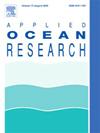Sea level forecasting using deep recurrent neural networks with high-resolution hydrodynamic model
IF 4.3
2区 工程技术
Q1 ENGINEERING, OCEAN
引用次数: 0
Abstract
Changes in climate, along with increasing marine activities in coastal and offshore regions, highlight the need for effective sea level forecasting methods. In recent years, forecasting techniques, especially those utilizing machine learning/deep learning methods (ML/DL), have shown promising capabilities. However, sea level forecasting is often limited in accuracy and spatiotemporal coverage, primarily due to the challenges posed by available observational data, which complicates the assessment of existing ML/DL techniques in complex and dynamic regions like the Baltic Sea. This study addresses these challenges by utilizing a high-resolution spatiotemporal framework that integrates high-resolution hydrodynamic and marine geoid models available to Baltic countries, enabling further capabilities to be explored in terms of sea level accuracy and validation. Specifically, it examines short-term sea level forecasting in the eastern Baltic Sea and the potential of utilizing two recurrent neural network-based models such as the Long Short-Term Memory Networks (LSTMs), and the Gated Recurrent Unit (GRU) along with high-resolution input data sources. These models were specifically chosen, due to their expected capabilities with time series data and their ability to learn both short and long-term connections of the input datasets.
To achieve this, a multivariate multistep-ahead (3, 6, 9, 12, and 24 h) forecasting framework was developed. The DL models' input components are high-resolution sea level data obtained from a bias-corrected hydrodynamic model, wind speed, surface pressure, and sea surface temperature. Results for various time steps (from 3 h to 24 h ahead), during the test period, revealed that the two DL models generally showed similar performance, with slightly superior results with the GRU model. For instance, GRU and LSTM showed an averaged root mean square error (RMSE) of 4.96 cm and 5.3 cm and a coefficient of determination (R²) of 0.93 and 0.92, respectively. Investigations of the time series forecasting performance at selected locations, also demonstrated the superiority of the GRU model, for all time steps, with Willmott's index (WI) values generally above 0.9 and high reliability as reflected in Prediction Interval Coverage Probability (PICP) values mostly exceeding 90 %. The results, however, weren't always perfect; both the GRU and LSTM models encountered limitations with forecasting the sea level maxima. Further examination of the spatial discrepancies also reveals some problematic areas in the eastern Gulf of Finland. This may have been influenced by the exclusion of some input components such as river discharge, salinity and meridional winds, further enhanced by complex hydrodynamics, extreme sea level variations, strong local currents, resonance-induced seiches and seasonal ice cover. In addition, an external validation of the GRU results was performed using along-track satellite altimetry from Sentinel 3A and 3B missions. For most of the satellite tracks, the discrepancy was better than 5 cm, proving the capabilities of the model generalization capabilities. These findings hold significant implications for advancing our comprehension of oceanic dynamics, enhancing maritime safety, and benefiting a wide range of applications that are dependent on accurate sea level forecasting.
基于高分辨率水动力模型的深度递归神经网络海平面预报
气候变化,以及沿海和近海区域海洋活动的增加,突出表明需要有效的海平面预报方法。近年来,预测技术,特别是那些利用机器学习/深度学习方法(ML/DL)的预测技术,已经显示出了很好的能力。然而,海平面预测的准确性和时空覆盖范围往往有限,这主要是由于现有观测数据带来的挑战,这使得波罗的海等复杂和动态地区现有ML/DL技术的评估变得复杂。本研究通过利用高分辨率时空框架解决了这些挑战,该框架整合了波罗的海国家可用的高分辨率水动力和海洋大地水准面模型,从而能够在海平面精度和验证方面进一步探索能力。具体来说,它研究了波罗的海东部的短期海平面预测,以及利用两种基于循环神经网络的模型(如长短期记忆网络(LSTMs))和门控循环单元(GRU)以及高分辨率输入数据源的潜力。这些模型是特别选择的,因为它们具有处理时间序列数据的预期能力,并且能够学习输入数据集的短期和长期连接。为了实现这一目标,开发了一个多元多步超前(3,6,9,12和24小时)预测框架。DL模型的输入分量是高分辨率海平面数据,这些数据来自经过偏置校正的水动力模型、风速、表面压力和海面温度。在测试期间,不同时间步长(提前3 h至24 h)的结果显示,两种DL模型的性能基本相似,GRU模型的结果略优于GRU模型。例如,GRU和LSTM的平均均方根误差(RMSE)分别为4.96 cm和5.3 cm,决定系数(R²)分别为0.93和0.92。对选定地点的时间序列预测性能的调查也表明,GRU模型在所有时间步长上都具有优势,Willmott指数(WI)值普遍在0.9以上,预测区间覆盖概率(PICP)值大多超过90%,可靠性高。然而,结果并不总是完美的;GRU和LSTM模式在预测海平面最大值时都遇到了局限性。对空间差异的进一步研究也揭示了芬兰湾东部一些有问题的地区。这可能是由于排除了一些输入成分,如河流流量、盐度和经向风,而复杂的流体动力学、极端的海平面变化、强烈的局地水流、共振引起的淤塞和季节性冰盖进一步加强了这些输入成分。此外,利用哨兵3A和3B任务的轨道卫星测高数据对GRU结果进行了外部验证。对于大多数卫星航迹,误差在5 cm以上,证明了模型泛化能力的能力。这些发现对于提高我们对海洋动力学的理解,加强海上安全,以及对依赖于准确海平面预测的广泛应用具有重要意义。
本文章由计算机程序翻译,如有差异,请以英文原文为准。
求助全文
约1分钟内获得全文
求助全文
来源期刊

Applied Ocean Research
地学-工程:大洋
CiteScore
8.70
自引率
7.00%
发文量
316
审稿时长
59 days
期刊介绍:
The aim of Applied Ocean Research is to encourage the submission of papers that advance the state of knowledge in a range of topics relevant to ocean engineering.
 求助内容:
求助内容: 应助结果提醒方式:
应助结果提醒方式:


